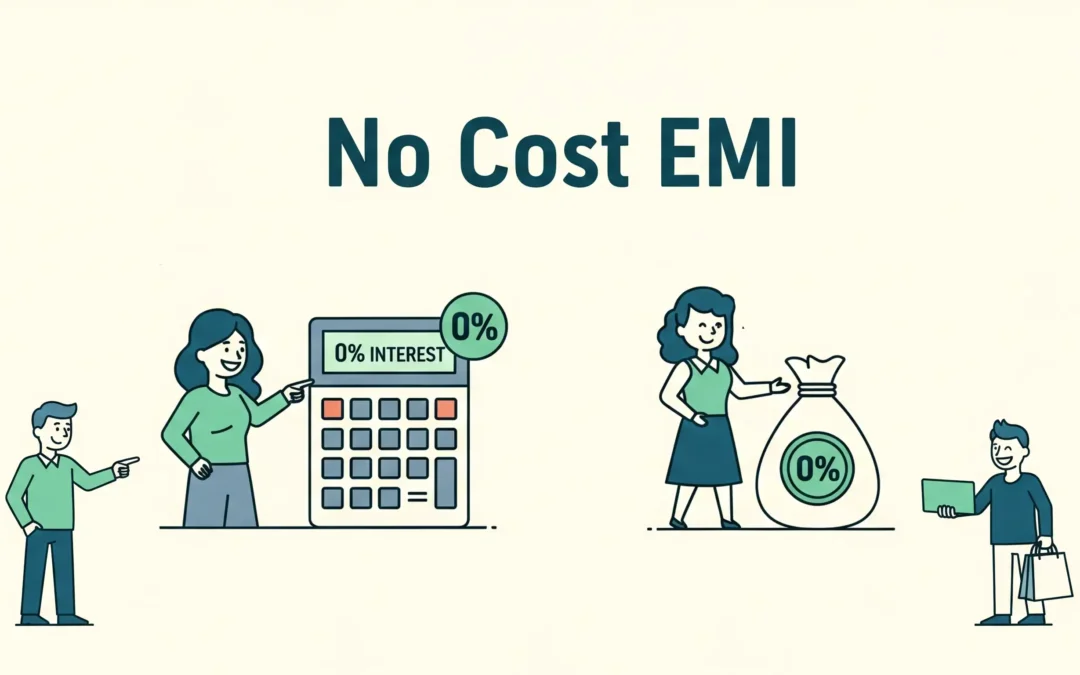Buying a new thing is always fascinating and exciting. But, bearing huge costs at once can be a major hit to the budget. EMIs help in such cases to divide the payment across several months. But what are no-cost EMIs? Are they really profitable or just an illusion of being profitable?
This article will explore all the hidden costs involved, which are not directly disclosed to the borrower but are charged anyway. Let us understand the truth of no-cost EMIs.
Are No-Cost EMIs an Illusion?
The No Cost EMI payment plan allows you to divide a purchase’s cost into monthly instalments without incurring additional interest. However, the interest is frequently concealed by price adjustments, processing fees, or lost discounts.
Paying in instalments with no additional interest sounds ideal. However, if something seems too good to be true, it usually is. Let’s understand if a no-cost EMI is actually free? Or is it merely a delusion?
Who bears the interest?
The fact is that interest is always paid by someone, and it’s usually you, though not in the way you might expect.
- Interest is not waived off in a no-cost EMI plan, but is adjusted.
- It is absorbed as part of a marketing agreement by the retailer or brand.
- It is offset by changing the amount of the discount, usually lower than you would have otherwise gotten.
- Integrated into the cost of the product, so you’re paying for it covertly.
For instance, during a sale, a mobile phone that is listed for Rs. 30,000 is being offered for Rs. 27,000 if you pay at that instant. However, it is sold for Rs. 30,000 without a discount under a No Cost EMI. Therefore, you lose the Rs. 3,000 discount, which essentially turns into your interest, even if you aren’t paying “interest.”
| Purchase Mode | Listed Price | Discount Offered | Effective Cost |
| Full Payment | Rs. 30,000 | Rs. 3,000 | Rs. 27,000 |
| No Cost EMI | Rs. 30,000 | Rs. 0 | Rs. 30,000 |
The Other Hidden Costs: You’re Not Usually Told About
Let us look at some other hidden costs that are usually not talked about but are still charged:
1. Processing Fee:
Lenders frequently impose a one-time processing fee, typically between 1% and 2% of the product value, even in “No Cost” EMI plans. You might not be aware of this additional expense right away because it is either added up front or taken out of your credit limit.
2. Requirement for Down Payment:
Some EMI plans may require a down payment (typically 10%–30%) upfront, especially for high-value items, but many ‘no cost EMI’ offers do not require any down payment. The requirement varies by lender, bank, and product.
3. Prepayment or Foreclosure Fees:
Some lenders may impose a 2%–5% foreclosure or prepayment penalty if you choose to close the EMI early, but this is not universal. Many credit card-based EMI plans do not have prepayment charges, while some loan-based EMIs do. Always check the terms specific to your loan or card before prepaying.
4. GST on Interest Component:
GST of 18% is charged on the interest and/or processing fee component (not on the principal), even if the interest is being subsidised by the seller or brand. This cost is sometimes included in the EMI calculation or shown as a separate fee, but it is ultimately borne by the consumer.
5. Loss of Discount or Cashback Offers:
Selecting No Cost EMI frequently results in the loss of flat discounts, holiday specials, or cashback that would otherwise be available upon full payment. This “lost benefit” turns into a hidden expense.
6. Inflated Product Price:
To compensate for the interest expense, sellers occasionally raise the product price for EMI purchases by a small amount. Therefore, you may be paying more than the going rate without even recognising it.
How Does It Affect the Borrower?
Let us know how borrowers are affected by it:
1. Blockage of credit limits
- The entire product’s value is deducted from your credit limit when you choose to use a credit card for an EMI.
- Suppose you purchase a TV on EMI for Rs. 50,000. Your credit limit is immediately reduced by Rs. 50,000.
- Your usable limit decreases, reducing your purchasing power.
2. Interest Risk for Late Payments
- Even a single day’s delay in paying your credit card bill could result in an increase in annual interest rate of up to 40%.
3. Impact on Credit Score
- Credit bureaus are notified of late or missed EMI payments. Your credit score can be lowered by even one default, which will make it more difficult (and expensive) to obtain future credit cards or loans.
Bottomline
The conclusion can be drawn that no-cost EMIs are just a myth. The charge is often covered by the borrower in one form or another, such as lost discounts, processing fees, taxes, potential down payments, or prepayment/foreclosure fees. However, not all schemes include all these extra charges, so it’s important to read the specific offer details closely.
The customers end up paying ultimately more in the name of no-cost EMIs. It is advised to understand the policy properly before opting for the same to avoid any regret later.


